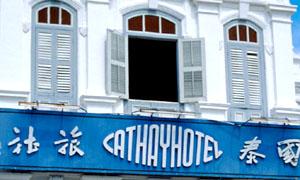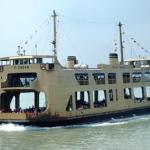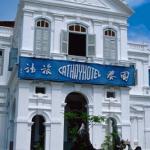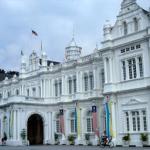Georgetown: Malaysia's Living Museum
(Complete with rickshaws, kopi-o, and a giant hair curler.)
I stand at the bow of the Pulau Kapas, a rusty car ferry chugging sedately away from the Malaysian mainland. Across the ship-strewn channel I can just make out the buildings of Georgetown, the main city on the island of Penang. I haven't been to Georgetown in ten years, and like a man meeting an old flame he hasn't seen in a very long time, I feel just a bit apprehensive. I've watched Asia change so much in the last decade, mostly for the better but sometimes for the worse, and wonder how Georgetown has fared. Will the city still be the same? Will I still be as captivated by this old colonial port on the Straits of Malacca?
As the Pulau Kapas noses up to the Georgetown ferry pier, I hoist my pack and prepare to find out.
Rickety Rickshaws Remain
Both the ferry and the terminal haven't changed one jot since my last visit in 1991, and this strikes me as a good omen. Outside the terminal I find a squad of bicycle rickshaw drivers frantically trying to wave me into the passenger seats of their beat-up contraptions. I'm pleased, if surprised, to discover that the rickshaws still ply the streets of Penang. This strikes me as another good omen, for I expected to see ranks of gleaming radio taxis rather than old-fashioned pedal rickshaws not much different from those in use a hundred years ago. Disembarking passengers in 1901 probably faced a gaggle of rickshaw drivers not much different from the gang I face today. I'm happy to see that the time-warpy nature of Georgetown hasn't changed a bit.
After a quick bargaining session, one driver agrees to pedal me to the Cathay Hotel for three ringgit ($0.75 USD). We set off on streets that look exactly as I remember them-sleepy, sun-bleached, and wonderfully old-fashioned. One pedal of the rickshaw has been replaced by an ungainly block of wood, but the driver makes do without complaint. The rickshaw's sprocket squeaks rhythmically as he skillfully avoids even the slightest rise in the pavement and makes use of the most imperceptible downslopes in this Kansas-flat city. We pass colonial edifices alternatively severe and ornate in their decor, then continue down narrow lanes fenced with Chinese shophouses, their paint peeling like some sort of tropical eczema. The cafes and coffee houses that cater to Western backpackers now offer internet access, but I can spot no other signs of change.
Like my rickshaw, the city looks well-worn. In spots it looks downright decrepit. This heartens me. For if old Georgetown hasn't been restored, at least it hasn't been lost to the wrecking ball.
Cathay Hotel Tarted Up for Hollywood
Ten minutes later we creak into the forecourt of the Cathay Hotel. Unlike most buildings in the old city center, the Cathay wears a coat of fresh white paint that covers the grime-streaked walls I recall from my previous stays. The afternoon sun glaring off the building nearly gives me a case of snow blindness. In fact, the Cathay looks so smart that I'm afraid it's gone boutique and hence beyond my price range.
My fears vanish like a popped balloon the moment I step inside the Cathay, for like an aging Hollywood actress opting for a face-lift, the Cathay Hotel has used a new coat of paint to conceal its age. It occurs to me that the paint may very well have come from Hollywood, as scenes from the movie "Beyond Rangoon" were filmed in the Cathay's forecourt. The hotel shines like the White House itself in the background of these scenes, but I quickly discover that it's just a façade. Inside nothing has changed.
I feel like I've never checked out, for the high-ceilinged lobby still looks as antique as ever, right down to the spittoons and peculiar saloon doors for the rooms. Elderly Chinese guests still shuffle about the interior courtyard, thermoses of tea in hand; songbirds still chirp in their wicker cages. Ceiling fans still whir gently overhead, clearly in no danger of being replaced by air-conditioners any time soon.
As with everything else in Georgetown, business at the Cathay is slow. I need no reservation, and the desk clerk swaps a room key for 69 ringgit ($19.00 USD). As I trudge up a long flight of stairs to my room-the hotel lacks an elevator, of course-I notice that the clock at the top of the staircase has stopped at 6:50. This seems emblematic of the hotel itself, not to mention the entire city, both of which remain stuck somewhere back in the days of colonial-era Penang.
Captain Light and Pulau Pinang
The colonial era officially ended in 1957 with Penang's independence within the Federation of Malaya, a grab-bag of ex-British colonies that later evolved into present-day Malaysia and Singapore. The colonial period had begun 171 years before, when Captain Francis Light acquired Penang island from the Sultan of Kedah in 1786. In return for Pulau Pinang-which translated literally as Betal Nut Island but became known simply as Penang-Captain Light promised that he and his East India Company would protect the sultan from his enemies.
Captain Light's new acquisition stretched nine miles wide and fifteen miles long, with peaks rising to over 2600 feet in the center. Light and his fellow colonialists decided to situate their colony on the island's coast, where they used convict labor to clear the swamp-jungle and erect the walls of Fort Cornwallis. This initial settlement soon expanded into a town named, inevitably, after the reigning British monarch. As a duty-free port following a free-trade philosophy, Georgetown quickly became a center for trade in tea, clove, nutmeg, pepper, chinaware, and textiles. In later years it became a key port in the tin and rubber trade.
As a maritime crossroads and commercial hub, Georgetown grew into a cosmopolitan city that welcomed political and economic refugees. Armenians, Jews, Achehnese, Chinese, Indians, and Eurasians joined the native Malays and ruling British colonialists. Each group profoundly influenced Georgetown's culture, cuisine and architecture. This cross-cultural mixing made the city a broad-minded and sophisticated place known both for its political machinations-Dr. Sun Yat Sen plotted his 1911 Canton uprising there-and for its unique cuisine. Penang curry, for example, has become a staple of Asian food menus worldwide. To this day, Georgetown's multicultural heritage ensures that it remains one of the most tolerant and least conservative cities in Malaysia.
Murtabak and kopi-o
The next morning I stroll over to the Taj Mahal Restaurant for breakfast. As I take a seat I remember how the Moslem cooks and I once watched the Gulf War unfold on their TV in the kitchen, our expressions an amicable mix of bewilderment and horror. Beyond the acquisition of a digital cash register and some modest remodeling, I can see that the Taj Mahal hasn't changed much since Sadaam's gambit in the desert. Certainly the food remains as cheap as it is excellent. I order my old breakfast favorites: murtabak ayam and kopi-o (thin roti stuffed with egg, chicken and vegetable along with sugared black coffee).
The breakfast crowd mirrors Georgetown's wonderfully diverse population, which in turn reflects the city's varied heritage. Georgetown, in fact, may be one of the most multilingual, multiethnic and multiracial cities in Asia. Indian women wear colorful saris and converse in Tamil over cups of tea. Chinese office workers grab breakfast on the way to work, mobile-phones strapped to their belts like sidearms. Malay Muslims sport ketayap skullcaps and keep their ears cocked for a nearby mosque's call to prayer.
To further spice the mix, European and North American tourists wearing shorts and T-shirts enter the restaurant, Lonely Planet guides in hand. Moving with purposeful Western strides unsuited to the heat, they resemble sun-crazed missionaries toting the good book.
Religion remains a highly visible aspect of life in Penang, which may be why I think of missionaries as I sip my sugary kopi-o. The people of Georgetown embrace a remarkably tolerant attitude towards religion-which certainly cannot be said of the entire country-that allows different faiths to coexist with relatively little friction.
After breakfast I stroll down Lebuh Chulia and over to the Kuan Yin Teng temple, dedicated to the goddess of mercy worshipped by the Chinese community. Next I explore the Sri Mariamman Hindu temple that caters to the Indians. Then I pass the Kapitan Kling Mosque favored by the Malays and move on to Saint George's church, which attracts a congregation that mirrors all the ethnic and racial groups of the city. I hardly wear out my shoes walking between these different places of worship, for all lie within a half mile of each other. The devotees amicably cross paths without so much as a second thought, joss sticks and holy books in hand.
The Sun Has Set but the Buildings Remain
I continue down to the waterfront along thoroughfares overshadowed by grand colonial buildings left over from the days when the sun never set on the British empire. Eventually I reach Georgetown's clock tower, which keeps accurate time despite being a colonial anachronism. Dedicated to Queen Victoria, this Leaning Tower of Penang cants slightly to one side due to Japanese bombing during World War II. The walls of Fort Cornwallis stand nearby, though they protect a museum now rather than a British military garrison. From atop the ramparts I can see the padang, a pleasant park facing a waterfront promenade where Captain Light first came ashore to claim the newest piece of Britannia.
I head a few blocks inland and spend the afternoon wandering the warren of narrow lanes that comprise the heart of the old city center. On many streets the shophouses stand in shoulder-to-shoulder solidarity. They front directly on the pavement, and their covered arcades serve as shaded sidewalks. No more than two or three stories tall, the shophouses feature tiled roofs tufted with TV antennas. But though television has broken into the yesteryear atmosphere of the shophouses, air-conditioning still seems largely unknown. As a defense against the blazing heat, the shophouse cafes, restaurants, stores, and guesthouses rely on wheezy electric fans, feeble sea breezes, rattan awnings, and long midday naps.
Taking Refuge in the Giant Hair Curler
Rather than take a nap, I head for the air-conditioned shopping malls that butt up against the edge of the old district like well-heeled party crashers. Instead of a street map, I use the Komtar tower as a navigational tool. The only true high-rise in the area, the Komtar juts up over the city like a giant up-ended hair curler. I can see it from any point in the city, so it's no problem to find.
Soon I'm entering the shopping mall complex that crouches at the Komtar's feet like an obedient dog. New when I first shopped there ten years ago, the complex has now lost its glitter and become a bit tatty. Perhaps in two-hundred years-if the residents of Georgetown can stand having the giant hair curler around that long-the Komtar will become a classic structure that adds to city's heterogeneous architectural heritage. In the meantime, however, it will continue to loom over Georgetown in all its ugly glory.
The brand-new Prangin mall next door has sprouted up like a young man beside his middle-aged father. A sparkling outpost of ultramodern Asia, the Prangin mall offers me a cutting-edge consumer experience complete with the obligatory Starbucks and McDonald's restaurant. On the ground floor I watch a TV crew filming a live game show hosted by two young Chinese women in pink Jetson-like retro space outfits. This spectacle fits Penang, an island now known for its high-tech industries, but it jars with downtown Georgetown's sleepy approach to the cyber age.
Georgetown's Future: Hong Kong or Macau?
Though it hardly seems apparent when walking through Georgetown's old city center, with its rickshaws and narrow lanes, I know that Penang as a whole is rocketing towards the future. The island's economy now hums to the tune of venture capitalists, multinationals, and foreign direct investment. One of the longest bridges in Asia connects the island to mainland markets; satellite phones and the internet connect the island to the global economy. On an island with an expanding economy, land equals money and lots of it, leaving the old city wide open to the threat of redevelopment.
The next afternoon I make my way to the Penang Heritage Trust, an organization dedicated to preserving Georgetown's historic city center. I want to see if the trust members can offer some sense of the city's future. I hope they'll tell me that the city has decided against following the Hong Kong model, where anything more than ten years old gets torn down and replaced by a taller and sleeker building hard-wired for the computer age. Hong Kong may be a fascinating, vibrant and dynamic city, but it has sacrificed its history on the altar of the free market. A metropolis with a present and a future, Hong Kong no longer has a past. Very few old buildings remain, and those that do huddle forlornly in the shadows of hundred-story high-rises.
Instead of Hong Kong, I hope that Georgetown will look instead to Macau, which has lovingly preserved its colonial streets and buildings. Macau's past remains intact and fully integrated into daily life; the old Portuguese buildings still serve faithfully as businesses, restaurants, homes, churches, and government offices. To visit Macau is to tour a living museum displaying a unique mix of cultures and traditions. Surely this should be the future of Georgetown, a place with the heritage to evolve into a world-class historic city.
The Penang Heritage Trust turns out to be closed. Probably the staff is off working with city planners to preserve the old district and keep modern Asia on the outskirts of the city. Or perhaps they have simply decided to take a well-earned nap. After all, these forward-thinkers and their allies have managed to keep the city center remarkably homogenous and true to its original architecture. Few new buildings break up the shophouse rows; no chain store or restaurant disturbs the old-world ambiance of the streets, barring a single 7-11 convenience store. The city's long-range plans involve the establishment of historic zones protected from development by laws with real teeth. This will go hand in hand with the restoration of old buildings, more than a few of which look derelict or nearly so.
Ironically, restoration can sometimes be worse than the status quo, as I discover when I stop in for a beer at the Eastern and Oriental, Georgetown's most famous colonial-era hotel. Ten years ago I drank gin and tonics in the E&O's dusty wood-paneled bar, a clubby pub-like place redolent with vintage colonial atmosphere. Since then the E&O has been completely renovated and lost much of its charm in the process. The sterile lobby offers a great circular expanse of marble reminiscent of a helicopter landing pad; the cozy colonial watering hole I remember has morphed into a generic sports bar, albeit with a great view of the shipping channel and hazy green mainland. To my disappointment, the E&O has become a somewhat generic luxury hotel where history and character have been swapped for efficiency and modernity.
I certainly can't say the same of the funky Cathay Hotel, with its erratic water supply and broken clock. I'll be the first to admit that the hotel could use some new plumbing and maybe a bit more painting, but a thorough renovation would wreck the Cathay as sure as a killer typhoon. The same could be said of the entire old city center.
Check Out at 6:50
When I check out of the Cathay around noon several days later, the clock at the top of the stairs still says 6:50. But the big clock behind the check-in desk, I notice for the first time, actually works. The clerk, moreover, sports a fancy digital watch. So it turns out time hasn't completely stopped at the Cathay, though I wouldn't exactly say it's speeding forward either. Perhaps this symbolizes the entire island. The old district remains in the past, preserved like a fly in amber, while the rest of Penang heads for the high-tech future.
I catch a rickshaw down to the waterfront, where I board my ferry for the mainland. As it has for decades, the ship churns out into the channel past freighters, tankers, and fishing boats. I lean against the rail and watch the giant hair curler recede into the haze. I'm hoping that I won't wait another ten years to return, but hoping even more that if I do wait that long, I'll come back to find Georgetown much the same, from the kopi-o and the Kapitan Kling to the clock tower and the Cathay. And yes, I even hope the Komtar will welcome me back, its glass windows flashing in the sun like a lighthouse beacon guiding a ship home to a familiar port.
* * * * *
 ThingsAsian
ThingsAsian



















